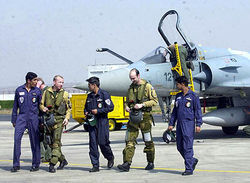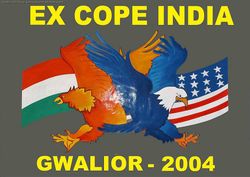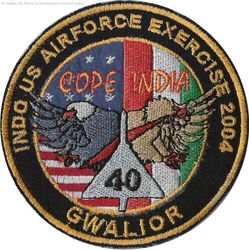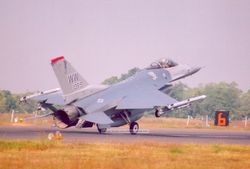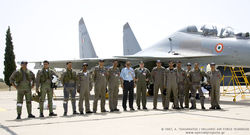Soldiering is not a profession which gives one the opportunity to learn on the job. The lessons thrown up by realistic exercises play an important role in a soldier’s training for war. This article is a look at the IAF’s participation in various International exercises between 1999 and 2007, and the lessons it learnt from its international exposure.
Soldiering is not a profession which gives one the opportunity to learn on the job. The lessons thrown up by realistic exercises play an important role in a soldier’s training for war. This article is a look at the IAF’s participation in various International exercises between 1999 and 2007, and the lessons it learnt from its international exposure.
Exercise Cope India 2004, the first of a series of exercises involving IAF and USAF was meant to be a routine affair for the latter since their air and ground crew participate in such exercises with the air forces of a number of countries round the year. However, their experience at Gwalior in the spring of 2004 left them flabbergasted as the IAF, equipped with mainly Russian aircraft of the ‘cold war’ era, was more than a match for their F-15s in practically every aspect of tactical employment. The publicity that followed created quite a buzz in professional circles. Even shorn of the jingoism this was a remarkable result as for the first 50 years since independence the IAF had not carried out a single exercise with any foreign air force. The first fighter-fighter level exercise opening occurred in 2003 when the French Air Force carried out Ex Garuda, also at Gwalior. Prior to that the only international interaction occurred when IAF crew were sent for initial training for new aircraft, weapon and equipment inductions. However, these were not exercises as the air and ground crew went with the express intention of initial conversion training. There was other contact as well, for instance when officers were sent to attend courses pertaining to weapons, aircraft testing, instructor school or staff courses. Although the IAF personnel excelled and often brought back top honours, these courses did not involve tactical flying the way it is done in full scale exercises and were limited to a few individuals.
As a result of these factors, the IAF was not exposed to any international environment and remained isolated from the evolution of the employment of air power as used by other modern air forces, although its own combat philosophy did not remain static. Some air force historians will point out that there was a major international exercise involving USAF, RAF and RAAF in 1962-63 in the form of Exercise Shiksha. However, this was not so much an ‘exercise’ as a show of strength, solidarity and support to India against communist Chinese expansionism in the aftermath of the 1962 Sino-Indian war. The foreign air forces had not come to India tactical interaction with the IAF but to buttress air power and to boost the morale of the nation.
As in many areas of application of air power by the IAF, the transport fleet led the way. The international exercise ice was broken not by the fighter fleet but by transport aircraft, the first foray being in 1999 when a single IL-76 aircraft participated in Exercise Blue Crane in South Africa. This was a multi-national exercise based on a UN Peace Keeping scenario and involved para-dropping, insertion of Special Forces and precision flying in different kinds of terrain. Since the IL-76 had entered IAF service in 1985 and had not undergone any major modifications or upgrades to its avionics the participating crew had to make do with the relatively primitive equipment on board. But having operated under the harshest of weather conditions and over the world’s toughest terrain for many years meant that the crew were extremely capable and the final result showed this. Apart from South African ground elements, troops from the armies of Zambia, Zimbabwe and Namibia participated. Although the exercise format was such that there were no ‘winners’ or ‘losers’, the most ‘valuable’ team was given the honour of airlifting the DAs and senior diplomatic staff from the exercise sites to Durbana for the final debrief and to attend the naval exercise that followed. This prestigious trip was done by IAF’s IL-76. This successful initial foray gave a boost to the self confidence of the IAF.
Exercise Cope Thunder
The next IL-76 foreign expedition was to Alaska for Ex Cope Thunder, again a multi-national exercise, involving combat, helicopter and transport forces from a number of countries. This was the first time that an aircraft of USSR/Russian origin was participating in an exercise in the USA. IAF’s gentle giant transport aircraft won plaudits for its capabilities, mission readiness and flexibility of operations. More importantly, it was evident that the performance of the crews was at par with the best in the world, despite definite shortcomings in the on board equipment. The IAF also learnt to deal with the problems of long-range logistics to keep the aircraft mission ready without break. On the other hand, the USAF and other air forces recognized that the Indian crews were highly trained and motivated, could handle different missions with ease and were comfortable with the English language.
Meanwhile at the political level it was recognized that India’s geo-strategic interests, which extend deep into the Indian Ocean region, extending thousands of kilometres into the sea, from the Straits of Hormuz in the west to the Malacca Straits in the east, would have to be backed by a matching military capability, of which air power would be a significant part. But this meant not just procuring the aircraft, hardware and equipment, it also made international exposure an imperative. As the political climate in India changed it was recognised that globalization of the economy had to include globalization of the military machine as well. Consequently, interaction with foreign air forces was no longer seen in a negative light. Further, the improving economy meant that there were funds available for such forays. Last, but not the least, the general acceptance of the capabilities of IAF air and ground crews by western air forces led to the gradual breaking down of governmental reluctance to allow the IAF combat crews to intermingle professionally with their counterparts from other countries, albeit selectively. Thus started the planning of the exercises that were to follow marking New Delhi’s desire to strengthen ties with Western militaries.
The next exercise was with the USAF bringing in five C-130H Hercules tactical transports with about 200 well trained paratroopers. Two IL-76 and 8 AN-32s made up the IAF’s element, with 400 army paratroopers. The combined forces carried out several combined exercises from Agra. The IAF crew picked up valuable lessons in precision night drops, while the Americans learnt about HAHO (High Altitude High Opening) parachute operations. There were other less obvious learning points regarding the pre-flight briefing & communication procedures, ground handling of aircraft and maintenance issues. The interaction between the army and air force personnel created tremendous camaraderie and professional respect for each other’s professional competence.
Exercise Garuda 1
The summer of 2003 saw six Mirage2000-5s of the French Armée de l’Air arriving at Gwalior for Ex Garuda-1, the first ever exercise that was to involve tactical manoeuvres by the IAF with a foreign air force. On the Indian side, in addition to the locally based Mirage2000H and MiG-27s, Jaguars and Bisons (upgraded MiG-21bis) participated. The radar control for all the air engagements were provided by ground based radars by creation of Control & Reporting Centres (CRC) by linking up two or more radars and controlled entirely by IAF Fighter Controllers. After the initial familiarization and limited 1 vs 1 combat sorties the exercise progressed in complexity to multi-aircraft formations, beyond visual range (BVR) engagements, multi-dimensional CAP-strike-escort missions and ended with up to 8 (4 vs 4) aircraft in a combat situation. While the Jaguars and MiG-27s were used only for ground attack missions, the Bisons and Mirage 2000s were either used for escorts or as Air Defence CAP missions.
Each mission started with a very detailed briefing and ended with an equally incisive debriefing. It was clear from these that the crew on both sides were well matched in their training levels and specialized skills. The lessons learned in each mission were then further studied, often late into the night and corrective actions implemented. However, midway through the exercise, as the missions increased in complexity, the IAF pilots and ground controllers realized that they were being out-manoeuvred quite frequently. Initially this was attributed to better radar and avionics on the FAF Mirage2000s, although efforts were made to overcome the shortcomings by anticipation and tactical action. But the overall honours definitely went to the FAF.
Further study of the situations was carried out, with the help of the Tactics & Combat Development Establishment (TACDE) by playing back the ACMI tapes, as well as the RT logs, long after the departure of the FAF detachment. Finally, the real reason emerged : it was the over-cautious approach by IAF crew to use the freedom of the third dimension, in other words sticking to specified heights even though tactically it was unsound to do so. For instance, in a multi-dimensional mission, strike, escort and CAP aircraft were required to maintain specified heights even though the situation demanded tactical manoeuvring in the vertical plane. The FAF pilots soon realised this idiosyncrasy of the IAF pilots/controllers and took advantage of it. The main cause of this rigidity was on considerations of Flight Safety as for many decades the IAF did not have 3-D ground and airborne interception radars (with the exception of Mirage2000 and MiG-29s), which made it essential to maintain vertical separation by procedural control. Over the years this had become a habit and since in-house exercises placed the same restrictions on both sides 3-D manoeuvring was failed to be recognised as a tactical disadvantage.
As soon as this lesson was highlighted, there was a deliberate attempt to water down the restrictions that the IAF had placed on itself , that is to allow flight safety to over-rule tactical considerations. It was decided that the restrictions on change of altitude by attackers and defenders were to be eased in a graduated manner over a period of about a year. It started by re-training aircrew and radar controllers on the need to utilise the maximum vertical envelope without restrictions when the horizontal separation was adequate for safety, as well as when suitably equipped fighters (eg Mirages, Bisons, MiG-29s and Su-30s) were ‘mixing’ in combat. The graduated dilution of these restrictions were to have a salutary effect on the subsequent series of exercises.
Exercise Cope India 1 (2004)
Exercise Cope India was planned for February 2004 and the USAF brought in six F-15C/Ds. From the outset, this exercise gave the impression of inadequate preparation by the guests. Firstly, due to logistics and maintenance problems the arrival of the USAF detachment was spread over four days; three of their fighter aircraft having got stuck on their way, at Bangkok, due to snags and lack of spares for rectification. This delayed the exercise commencement although the available crew did carry out some area familiarisation and basic dissimilar air combat. Much of the early briefings, a time consuming task, had to be repeated after the arrival of the remaining team. Subsequently, as the exercises got more complex it was clear that the American pilots felt hamstrung by a lack of situational awareness, something they took for granted in normal circumstances but had to do without as they had no AWACS. Although faced with similar shortcomings the IAF pilots soon gained the edge. The primary reason was not far to seek. As mentioned earlier in the context of IL-76 operations, fighter pilots (and helicopter crews, too) in the IAF are used to flying without the latest electronic aids being available on call. Thus their visual awareness bubble is larger, they are adept at manoeuvring a number of aircraft even under BVR combat conditions without reference to basic aids such as TACAN and building up a mental picture of a tactical situation even as it is developing. Another reason could have been the feedback received by the USAF from the FAF regarding the way the IAF pilots flew during Ex Garuda-1 just 8 months earlier, not realising that the IAF had drawn its lessons and corrected for them in double quick time.
Thus despite having the sophisticated and powerful F-15C/D with the AN/APG-63(V) AI radar, matched with the AIM-7F/M and AIM-9X, the US pilots were outmanoeuvred and out flown in practically all aspects of the exercise. The visitors were clearly shocked and said so during the final interaction with the news and media persons who were given a chance to meet the representatives of the two air forces. There was some truth in the allegations that the publicity given to the ‘poor’ performance of the F-15 was to put pressure on the US Congress to release funds for the successor F-22 Raptor, but it was clear that the USAF had come away with a very deep respect for the IAF crew and their aircraft
Cope India 2004 – The Indian Perspective
Even as Ex Cope India-1 was in progress, the planning for the next international exercise was taking place in the background. It was decided that Jaguar fleet was to be flown more than halfway across the globe to USA for Ex Cope Thunder, which is conducted four times a year and held in the vast expanses of Alaska, providing unmatched freedom for tactical manoeuvres from ground level to high altitude, unhindered by commercial air traffic. IAF’s participation was to be 6 Jaguars, two IL-78 tankers and two IL-76 freighters. Although the numbers don’t sound like much, it is worth mentioning that the positioning of the IAF aircraft would involve a 14000 km journey, crossing many time zones and the Atlantic Ocean, activities in which the fighter crew had no experience at all. It will be recalled that the IL-78 with its Mid-Air Refuelling System (MARS) had been inducted into the IAF for the first time in February of that year and there was hardly any experience in carrying out air-air refuelling and no practical knowledge about the difficulties involved in flying long duration sorties in single-seat aircraft, that too without an autopilot.
Cope India 2004 – The USAF Album
The task of creating the bank of experience and expertise in MARS, as well as training the participants as a team, was left to Western Air Command and was centred at IAF’s base at Ambala. The planning for long distance international flights by tanker and fighters, collectively called a ‘trail’, was done with RAF help as they had a wealth of experience in such operations, especially with Jaguars. The route had to take into account the availability of airfields at suitable intervals, along with alternates, and prior diplomatic and logistics arrangements made. Most of these activities had never been done by the IAF earlier and a lot of problem solving had to be resorted to while sorting out the nitty-gritty.
After much planning and working out the political clearances, the route selected was Ambala-Jamnagar- Doha-Jiyakalis-Practica de Mare-Monte Real-Lajes-Gander-North Bay-Edmonton-Eielson. The shortest leg was 4 hours of flying, while the longest was 5 hours 30 minutes, with two aerial refuelling hook ups.
To prepare for the ferry flights, the selected aircrew carried out several long-duration sorties with the aim of building up flying stamina and coping with being strapped up in the ejection seat. It was essential to ensure that the crew of the single-seat jets should have the proficiency to carry out critical activities like mid-air refuelling and final recovery at unfamiliar airfields, in poor weather, even after flying for 5-6 hours. A typical training profile included Jaguars taking off from Ambala for a round trip to Bangalore, with a rendezvous (RV) with a tanker near Nagpur and carrying out mid-air refuelling on the outbound leg and repeating the same when homeward bound. On the return the pilots were required to carry out an instrument let down and ILS approach at Chandigarh before finally returning to home base. As the departure date neared, the confidence levels of the fighter and tanker crews rose as probe and drogue contacts were near 100% on the first attempt. Long duration flying created problems like boredom, loneliness, failure of mental alertness and bladder control. All these were addressed by the crew with the help of psychologists and aviation medicine specialists.
In between all this, the pilots continued their training on their primary Ground Attack missions, while carrying out a lot of homework to familiarise themselves with the instrument approach procedures at all the primary and alternate airfields, and memorising these as cockpit space did not permit the convenient carriage of the charts. Pilots also became adept at doing their own turn round servicing, which included refuelling, topping up of engine and hydraulic fluids and so on. The ground crew were also busy ensuring that their tool kits and spares inventory was adequate to cover every possible contingency during the ferry and the exercise. It was decided that all the maintenance equipment required for the transit flights would be carried aboard the tankers, which had a very useful spare capacity of about 10 tons, even when fully loaded with fuel. Ofcourse, the bulk of the ground equipment was carried in the cavernous hold of the accompanying IL-76s.
Exercise Cope Thunder
The two trails finally departed India on June 23rd and reached their destination on the planned date of July 7th. Among the myriad of diverse activities during the preparatory phase preceding the ferry, as also during the transit to Alaska, two merit special mention. The first was the modification of Jaguars with ILS, wherein airborne equipment meant for Su-30MKI aircraft was requisitioned for fitment on the Jaguars. The physical modification was done by HAL while the on board software was modified by Software Development Institute (SDI), a specialised unit of the IAF. Although only 6 Jaguars were to be taken to Alaska, eight were modified in order to provide backup redundancy against last minute unserviceability. All this was accomplished within 6 weeks of go-ahead sanction, thus giving the pilots adequate time to practice landings with this recovery aid. The second noteworthy occurrence happened at Edmonton AFB in Canada, where during the routine last flight servicing a deep nick was discovered in one of the fighter engines. Till then the ferry had been progressing flawlessly and on plan, which was one of the criteria set by the Chief of Air Staff for assessing overall mission success, albeit within the bounds of safety. The situation was far from ideal in that it was late evening, it was extremely cold, there was no hangar space available and the next day’s take off for the final destination (Eielson AFB) had been planned for 0800h. The engineering staff took stock of the situation and decided that since the ground crew were well rested during the long flight from North Bay and a spare engine, tools and ground equipment were readily available in the transport aircraft, they would work overnight to change the engine. When questioned about the bitter cold and darkness, the maintenance staff only shrugged and smiled away the problems! The upshot was that by the next morning the reengined aircraft was offered for an acceptance test and the trail got airborne merely a couple of hours behind schedule. All this indicated an extremely high level of engineering excellence, training and morale, and exhibited competence across the entire spectrum of skills needed to make this complex exercise a success.
Exercise Cope Thunder is held in Alaska and in addition to the USAF several other air forces participate. During 2004 the IAF had a chance to exercise with the air forces of Canada, Germany, Japan, Singapore and Mongolia. Officers from Korea, Sri lanka and Bangladesh were invited as observers. The aircraft that participated included F-15, F-16, F-18 and Tornado fighters, and E3A & B-767 AWACS.
Exercise Cope Thunder involves the entire gamut of air operations like reconnaissance, strike, air defence with AWACS, counter air, and a host of transport and helicopter operations, all going on in parallel. The aim of this series of exercises is to expose the participants to a well rounded learning experience, rather than to identify winners or losers. Lessons learnt are debriefed comprehensively and documented properly in order to improve the capabilities of all elements participating. In the instant case the IAF crew learnt a lot by flying under constant ground and airborne radar cover and inter-operating with other types of aircraft. Valuable tips were also picked up on how to extract maximum advantage with a limited number of tanker aircraft. Although there were no winners or losers, IAF’s Jaguar, transport and tanker crew came in for praise for their professionalism, competence and flexibility, achieving laid down success criteria despite the fact that they were in a totally new operating environment and operating 2nd generation navigation and fire control avionics. One of the key indicators of operational readiness was that all the 10 Indian aircraft achieved 100% serviceability and mission availability throughout the exercise period, a tribute to the skills of the maintenance crew. An interesting observation was that the IAF had taken fewer ground personnel than the RAF, Luftwaffe, RSAF and CAF, even though the number of aircraft was similar.
This exercise opened the flood gates for other international exercises with a detachment of six IAF Mirage 2000 aircraft going to South Africa to participate in Ex Golden Eagle at SAAF Base Hoedspruit. The five day exercise was based on a fictitious scenario of a “Blue Force” whose country was being destabilized by rebels trying to dislodge the democratically elected government. These rebels were receiving material and assistance from an external country – the “Red Force”. In order to prevent further assistance to the rebels the Blue Force was tasked to conduct a special forces raid on the AFB Hoedspruit, where the Red Force was based. The Blues were centered around AFB Louis Trichardt. The IAF was part of the Red Forces. The participants included Luftwaffe C-160s, SAAF Cheetah C/Ds and Impala strike aircraft. UAVs also took part in this exercise
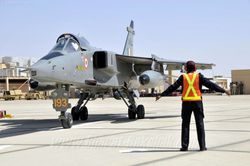 |
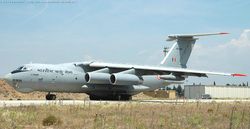 |
 |
| Exercise Eastern Bridge in Oman (2009) | Exercise Garuda II – Istres AFB, France 2005 | Illyushin-76 at Hawaii |
This was followed by three engagements in 2005; the first one was with the FAF, held at the French Air Force base at Istres. Ex Garuda-2 signalled France’s interest in cultivating defence links with India, perhaps a recognition of its growing economic and military power, which is looking to augment its forces with multi-role long range combat aircraft. The main feature of this exercise was that this was the first time that the IAF had sent Su-30K overseas and the team was a composite mix of aircrew and fighter controllers. Although certain electronic emission restrictions were placed on the fighters, the overall learning value was immense and unlike the earlier ‘loss’ to the FAF, the teams were more evenly matched. The FAF put up Mirage 2000 (RDI AI radar), M2000-5D (RD4), M2000N (strike role), Tucano (slow moving threat), C-135Fr AAR tankers and E-3F AWACS. A cameo appearance by the Rafale was the icing on the cake. IAF fighter controllers were allowed guide fighters using the latest ground radars and getting a close look at the AWACS techniques. The most lasting impression brought back by the controllers was of the superb integration of the entire airspace and sensors, military and civilian. This knowledge will, no doubt, be of immense use when the IAF acquires its Phalcon equipped AWACS next year, as well as when the military and general airspace boundaries and sensors in India start to get fully linked through the Integrated Air Defence Command & Control System.
Exercise Cope India 2
Cope India 2006 – Photos by Sanjay Simha
The second exercise that year was with the USAF held at Kalaikunda. A part of the Cope India series, this exercise saw all types of Indian fighters tangling with 12 F-16s Fighting Falcons for the first time. This detachment consisted of 250 personnel including airmen from the 961st Air Control Squadron from Kadena Air Base, Okinawa, which is a part of the Pacific Air Forces. This set of war games had special operational significance as the F-16 is the mainstay of the PAF. The exercise was designed as to give as much exposure as possible to the entire diverse fleets of the IAF to carry out dissimilar air combat with this type. However, once again, to ensure that the main gain was interoperability, the multi-ship formations were invariably a mix of USAF and IAF aircraft. As always, it was a great learning experience for both sides. In particular, for most of the US pilots it was a chance to get to see at close quarters the aircraft they had studied in intelligence briefs during the Cold War years, but never seen for real.
Surprisingly, despite the close relationship that IAF maintains with the British forces, the first exercise with RAF took place as late as 2006 when the latter brought a detachment of Tornados to Gwalior, accompanied by a VC-10 tanker and a E-3D AWACS. This exercise was of significance for the IAF as it focussed on precision strike under heavy electronic warfare conditions. While the IAF has been practicing precision attacks using laser guided kits strapped on to indigenous bombs and Russian origin air-surface missiles using TV/IR command guidance, the greater experience levels of RAF pilots in using NATO standard PGMs provided the IAF crew with an insight into the potential of weapons using the state of the art avionics and electronics. AWACS provided the all important training to IAF’s Fighter Controllers.
The same year also saw F-16s descend on Kalaikunda again, but this time in the colours of the Republic of Singapore Air Force (RSAF). This once again gave a chance to the IAF crew to learn more about the performance of this agile fighter. The same exercise, but with a different set of personnel was repeated in 2006. The RSAF used these opportunities to check out the facilities at Kalaikunda as they have been asking the Indian Government for a training base in India for over 20 years. The recent decision of the GOI to finally allow the RSAF to use the base facilities, including the nearby air-ground range at Dhudkundi for their offshore training is the result of this effort. The base will definitely see further upgradation over the next few years to meet the specific requirements of the RSAF, which will eventually end up as being assets for the IAF. The details of the MOU with the Singapore Govt are not known, but there are bound to be regular exercises with IAF units visiting the base from time to time, which will be a definite advantage due to the presence of F-16s. The final exercise that year was in September, when a single IL-76 took part in a logistics & air drop exercise with the 15th Airlift Wing at Hawaii.
Exercise Indra-Dhanush (2007)
Exercise Indra-Dhanush-2007 was the latest overseas deployment of IAF aircraft when six Su-30MKI aircraft escorted by IL-78 tankers flew from Pune to RAF Waddington, in just three hops, to carry out manoeuvres with RAF Tornado F3s and the latest Eurofighter Typhoons. This was the first time that the Su-30MKI and Typhoons took part in an international exercise and their mere presence on the tarmac caused a lot of heads to turn. In the air, the aircrew checked out the capabilities of these two advanced 4th generation combat jets. While the Typhoon was a fast and agile, the Su-30MKI took the manoeuvrability honours primarily due to its vectored thrust, which helped it gain the edge in close combat. However, to emphasise that size does matter, in visual combat situations the Typhoon pilots invariably spotted the huge Sukhoi aircraft at significantly longer ranges, thus gaining the initial advantage. By all accounts, the Typhoon exhibited a very creditable manoeuvring performance with its canards, although it was found to be somewhat less agile than the Su-30MKI. For the IAF the real training value of Ex Indra Dhanush lay in the concept of long range interceptions, BVR combat and experiencing the capabilities of the latest avionics.
The exercise dates happened to coincide with the Royal International Air Tattoo, for which the IAF provided one Su-30MKI for static display and the second one gave aerial performances daily. This team was awarded the “Graviner Spirit of the Show” trophy, which was an appropriate finale to the IAF’s first outing in UK. The daylong competition comprised 12 groups with four aircrews each from France, RAF, Jordan, Finland, Czechoslovakia, Netherland, Belgium, Italy, etc, who had to participate in a series of challenging physical competitions such as an obstacle course, group tasks, walk-in-the-water, shooting competition, first-aid treatment and aircraft recognition. “Apart from our peak fitness levels and competitive spirit, perhaps what really appealed to all others and the organizers was our camaraderie with all participants, who found us very professional yet endearing,” said team leader Sqn Ldr Garg of 30 Sqn (Rhinos).
What next? The IAF’s international exposure has bestowed a number of benefits on the service and the country. Apart from the obvious learning value, one of the major gains has clearly been the enormous boost to the self confidence of the men in blue, who now believe that in addition to being one of the largest air forces in the world, they are also equal to the best in terms of quality of hardware and manpower skills as well. With a large number of personnel now getting a chance to go abroad and widen their horizons, to be able to rub shoulders on an equal footing with their counterparts in other countries and to be treated with professional respect has had a salutary effect on their morale. Thus, the overall gain to the IAF has been invaluable and immeasurable. The other gain has been on the diplomatic front where the show of the Indian tricolour on foreign shores, including the countries of transit, has raised the general awareness of the military prowess of the nation. The ability to fly to distant places with minimal ground support has shown that India now possesses the capability to carry out its declared regional role effectively. The message cannot have been lost on other countries in the region. Last, but not the least, the goodwill and willingness of the IAF to become interoperable and to benchmark procedures and tactics with air arms of other countries has reduced the avoidable cloak of secrecy that unnecessarily surrounded the service in the past.
In these circumstances, it is essential that the efforts to create further opportunities for exercising with more air forces be pursued actively and continued. The recent proposal for the IAF to participate in the Red Flag series of exercises from Nellis AFB, on the outskirts of Las Vegas, are to be commended. Reg Flag is the acme of all air exercises as it is carried out in the most realistic environement, with appropriate tactical settings that stretch ground and aircrew to their limits. Over the years the underlying scenario for Red Flag series has undergone a change from its original Cold War flavour to a more generic projection of air power. The very fact that the IAF has been considered and invited to participate in this exercise indicates the high regard that the USAF has for the IAF and it would be not only be churlish to turn it down, but also a loss to the training status of the IAF. Overall, the IAF will gain enormously by taking active part in this exercise as it would not only provide wonderful lessons, but also allow our personnel to firm up ideas on how to carry out similar realistic exercises in India.
This article was first published in 2008.
